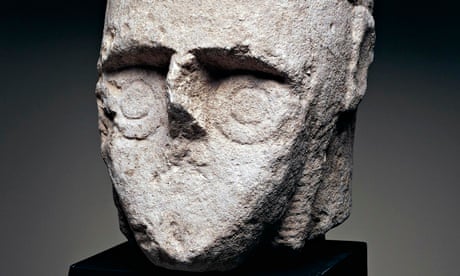Giant steps: mysterious Sardinian sculptures to go on display
The Giants of Monte Prama, inscrutable avatars of a lost civilisation, see the light after years of reconstruction work

The head of a warrior: one of the Giants of Monte Prama. Photograph: M Carrieri/De Agostini/Getty Images
Some of the most mysterious statues from antiquity are finally to go on permanent display this week – 40 years after they were discovered by a ploughman on the Italian island of Sardinia.
The Giants of Monte Prama include statues of archers, wrestlers and boxers carved in sandstone probably between the ninth and eight centuries BC, before Rome was even founded. They belong to the Nuragic civilisation, which flourished on Sardinia for two millennia until the second century AD.
The figures, standing over 2 metres (6.5ft) high, are distinguished by their unearthly eyes, which consist of two perfectly concentric circles. They – or rather, their component parts – were found in 1974 near the town of Cabras, on the west coast of the island.
But it was not until recently that funds were set aside for the daunting task of reconstructing the statues, which also include representations of nuraghe, the tower-fortresses after which the Nuragic civilisation is named. More than 5,000 pieces were dug up at the site.
Alessandro Usai, the curator of the permanent exhibition, which opens on Saturday at the national archaeological museum, in Cagliari, and the town museum of Cabras, said computers had been of limited use in the operation. “Most of the work was done by eye and by hand, using shape, type of stone and decoration as guides,” he told the Guardian. The reconstruction, which was completed in 2011, took four years.
The figures were discovered at a necropolis , so one theory is that the stone warriors guarded the tombs. But it has also been suggested that they belonged to an as-yet undiscovered nearby temple.
Usai said many other questions remained: “We don’t know how many there were altogether. Nor do we know if they were originally set out in lines or perhaps in squares.”
Usai said 28 of the works would go on show in Cagliari, while another 10 would be displayed in Cabras, where it is hoped the Giants will help promote tourism.
Usai said three-dimensional digital representations of the missing statues would be created at each site, “so that the two exhibitions will be complementary”.
Original post The Guardian
